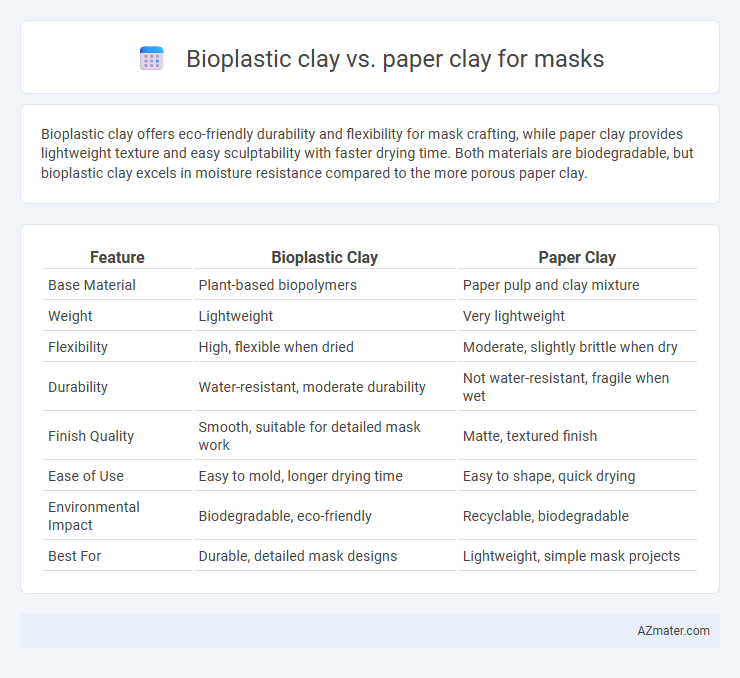Bioplastic clay offers eco-friendly durability and flexibility for mask crafting, while paper clay provides lightweight texture and easy sculptability with faster drying time. Both materials are biodegradable, but bioplastic clay excels in moisture resistance compared to the more porous paper clay.
Table of Comparison
| Feature | Bioplastic Clay | Paper Clay |
|---|---|---|
| Base Material | Plant-based biopolymers | Paper pulp and clay mixture |
| Weight | Lightweight | Very lightweight |
| Flexibility | High, flexible when dried | Moderate, slightly brittle when dry |
| Durability | Water-resistant, moderate durability | Not water-resistant, fragile when wet |
| Finish Quality | Smooth, suitable for detailed mask work | Matte, textured finish |
| Ease of Use | Easy to mold, longer drying time | Easy to shape, quick drying |
| Environmental Impact | Biodegradable, eco-friendly | Recyclable, biodegradable |
| Best For | Durable, detailed mask designs | Lightweight, simple mask projects |
Introduction to Mask-Making Materials
Bioplastic clay and paper clay are prominent materials in mask-making, each offering unique properties that influence the crafting process. Bioplastic clay, derived from biodegradable polymers, provides flexibility and durability suited for detailed, lightweight masks. Paper clay, composed of cellulose fibers and clay, is favored for its porous texture and ease of sanding, allowing artists to create delicate, breathable masks ideal for theatrical and decorative purposes.
What is Bioplastic Clay?
Bioplastic clay is a biodegradable modeling material made primarily from natural starches, such as cornstarch or potato starch, combined with plasticizers that provide flexibility and durability. It offers a non-toxic, eco-friendly alternative to traditional clays, making it ideal for creating lightweight masks with a smooth, paintable surface that hardens upon air drying. This material's water resistance and ease of shaping give it advantages over paper clay, which is generally more porous and less durable.
What is Paper Clay?
Paper clay is a type of clay mixed with cellulose fibers, enhancing its strength, flexibility, and lightweight properties, making it ideal for detailed mask-making. Unlike bioplastic clay, which is derived from renewable plant-based materials and offers a more elastic texture, paper clay allows for easier sculpting and sanding while drying to a hard, porous finish. Its porous nature also supports better adhesion of paint and other finishing materials, making it a preferred choice for intricate mask designs requiring durability and fine detail.
Material Properties Comparison
Bioplastic clay offers superior flexibility and durability compared to paper clay, making it ideal for masks requiring intricate detailing and long-lasting wear. Paper clay is lightweight and porous, allowing for excellent breathability but is more prone to cracking and less water-resistant. Both materials are eco-friendly, yet bioplastic clay generally provides better resistance to moisture and deformation under stress.
Sustainability and Environmental Impact
Bioplastic clay, derived from renewable biomass sources like cornstarch or potato, offers superior biodegradability and lower carbon emissions compared to conventional clays, making it a more sustainable material for mask crafting. Paper clay, composed of recycled paper fibers and natural clay, enhances recyclability and reduces landfill waste but may involve energy-intensive processing. Both materials contribute to eco-friendly mask production, with bioplastic clay emphasizing compostability and paper clay promoting resource reuse and minimal environmental footprint.
Ease of Sculpting and Detailing
Bioplastic clay offers superior ease of sculpting due to its pliability and smooth texture, making it ideal for intricate mask details and fine lines. Paper clay, while slightly more textured and porous, provides excellent workability for delicate features and allows for easy sanding and carving after drying. Both clays support detailed mask creations, but bioplastic clay excels in flexibility and immediate refinement without cracking.
Durability and Longevity
Bioplastic clay offers enhanced durability and longevity for mask-making due to its resistance to cracking and moisture damage, making it ideal for long-term use and repeated handling. Paper clay, while lightweight and easy to sculpt, tends to be more fragile and susceptible to water damage, reducing its lifespan unless properly sealed. For masks requiring robust wear and tear capabilities, bioplastic clay provides superior structural integrity compared to paper clay.
Weight and Comfort for Wearable Masks
Bioplastic clay masks tend to be heavier due to their denser, synthetic composition, which may cause discomfort during extended wear. Paper clay masks are significantly lighter, offering enhanced breathability and flexibility, making them more comfortable for prolonged use. The lightweight nature of paper clay also reduces pressure on facial features, improving overall wearability for mask applications.
Finishing, Painting, and Customization
Bioplastic clay offers a smoother texture and is less porous than paper clay, resulting in a more polished and refined finish ideal for detailed mask designs. It accepts acrylic paints well, allowing vibrant colors with minimal absorption, and supports a variety of custom shaping techniques due to its flexibility. Paper clay, being lightweight and breathable, provides a matte finish that can be easily sanded, painted with watercolors or acrylics, and customized with added fibers or mixed media for textured, artistic masks.
Cost and Accessibility
Bioplastic clay generally costs more than paper clay due to its eco-friendly materials and manufacturing processes, limiting accessibility for budget-conscious mask makers. Paper clay offers a more affordable option with easy availability from common craft suppliers, making it ideal for large-scale or educational mask projects. Both materials provide distinct benefits, but paper clay's lower cost and widespread access make it the preferred choice for cost-sensitive users.

Infographic: Bioplastic clay vs Paper clay for Mask
 azmater.com
azmater.com